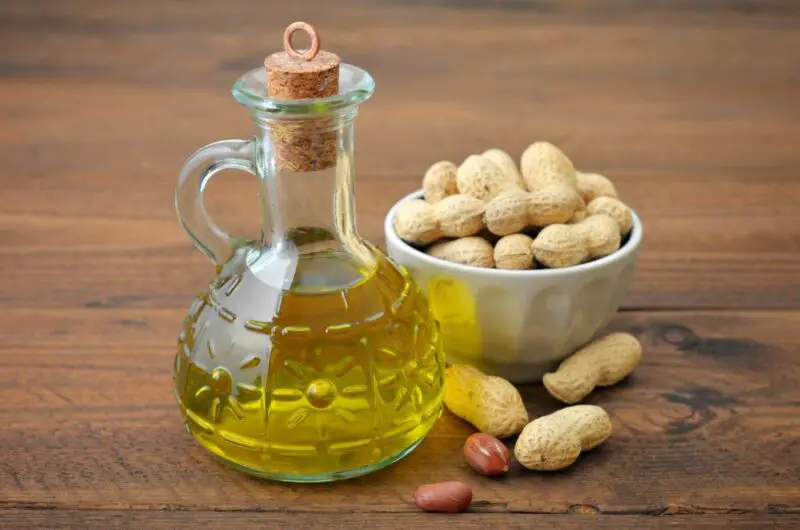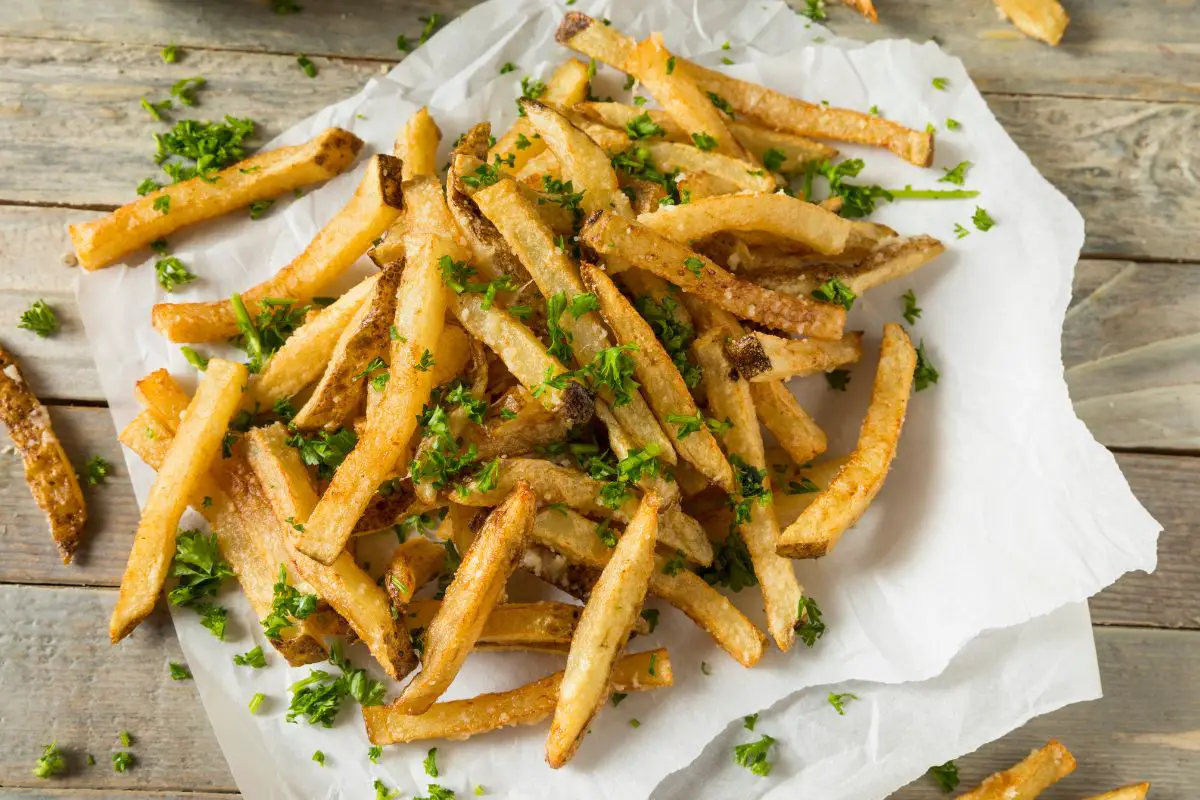Peanut oil is used in a variety of cuisines, including East Asian, South Asian, and African dishes.
It has a strong nutty taste and distinct fragrance, which is why it’s primarily used for sautéing and frying ingredients.
Even though peanut oil is a useful ingredient, there may be times when you need a peanut oil substitute.
Whether you have run out of the oil, can’t find it at the store, or don’t particularly love its flavor, several ingredients work well in its place.
You’ll find six of these peanut oil substitutes in this post for you to use in your kitchen.
We’ve also included some more information about peanut oil below, including its smoke point and its various types.

More About Peanut Oil
Peanut oil is a type of oil sourced from peanuts. You might have thought that peanuts were a type of nut, but they are really a type of legume, known as the pea plant family.
Peanut plants originally come from South America, but today, they are found all over the globe, like in the US.
Peanut plants have distinct yellow blooms above the earth, but their fruit develops underground, which is why peanuts are also called groundnuts.
Peanuts have a light, earth-like flavor, and velvety consistency. This is because they are high in fat, which is why they are also used to make fat-based items, like animal feed, soap, and cooking oil.
Peanut Oil Smoke Point
Peanut oils have a smoke point of roughly 445°F (229.4°C). A smoke point is a temperature where a particular oil starts to smoke.
As peanut oil has a high smoke point, it’s normally used in high-heat cooking techniques, like stir-frying or sautéing.
An oil’s fats begin degrading when it reaches its smoke point. At this point, oils can produce dangerous compounds, like ketones, aldehydes, and alcohol, which all influence their taste.
This is why it’s best to use high smoke point oils for high-temperature cooking.
You’ll often see fast food places fry things like chicken and french fries with peanut oil, but it’s also used in Southeast Asian, Indian, African, and Chinese cuisines.
Different Peanut Oil Varieties
Peanut oil is available in several different types, which all have their own taste and processing level.
These include:
Refined Peanut Oil
Refined peanut oil is generally used by restaurants to fry food. Refined peanut oil, like all refined oils, is chemically treated to eliminate allergens, improve stability, and create a neutral color and flavor.
This refining treatment eliminates allergens, which is why refined peanut oil is considered safe for individuals with peanut allergies – though this may not be applicable in some cases.
Refining may give peanut oil some advantages, but it also eliminates any nutrients that are beneficial to well-being, like vitamin E.
Peanut Oil Blends
Refined peanut oil is occasionally mixed with lower-quality oils, such as soybean oils.
These oil blends are specially produced for high-temperature cooking, which is why they are frequently purchased in bulk sizes.
Cold Pressed Peanut Oil
This type of peanut oil is thought to be an unrefined product, as it isn’t treated with the same methods that refined peanut oil undergoes.
Cold-pressed oil is sourced mechanically with bioactive molecules, like phytosterols and vitamin E. Cold-pressed peanut oil does have peanut protein, so it is not suitable for anyone with peanut allergies.
Roasted Peanut Oils
This unrefined gourmet oil is sourced from roasted peanuts, giving the oil a strong, nutty taste.
Roasted peanut oil has a lower smoke point compared to refined peanut oil, which is why it’s used for lower-temperature cooking. It’s also added to dressings, marinades, and sauces.
High Oleic Peanut Oils
This type of oil is made from peanuts that contain a greater amount of oleic acid, a substance that has been found to lower the risk of cardiovascular disease.
General types of peanuts contain roughly 52% oleic acid, but high-oleic versions contain much more, about 80%.
The 6 Best Substitutes For Peanut Oil
Peanut oil is a good ingredient to keep in your kitchen, but some reasons may make you need an alternative ingredient.
Running out of peanut oil, being unable to find it at the store, and desiring a different flavor are all examples, but another important factor is allergies.
Many people are sensitive to peanuts, and therefore, peanut oil. Peanut oil allergies can lead to issues, including skin reactions, throat irritation, difficulty swallowing, and trouble breathing.
Here are six substitutes you can use in place of peanut oil.
1. Almond Oil
Almond oil is a good substitute for peanut oil, thanks to its light, nutty taste.
It does tend to cost more, but its nutritional benefits may compensate for this. Almond oil is full of vitamin E and monounsaturated fats.
These can help support healthy eyes, skin, and immunity.
Almond oil comes in two main kinds, refined and cold-pressed. Cold-pressed almond oil is better for making dressings and sauces.
Refined almond oil is treated with similar processes to refined peanut oil, so it is better for frying purposes.
However, keep in mind that refined almond oil would have had its nutrients removed, just like refined peanut oil.
2. Canola Oil
Canola oil is also a nice peanut oil substitute. This oil is sourced from rapeseed plants, but it has a comparable nutritional value to peanut oil, as both are high in monounsaturated fats and low in trans fats.
Canola oil is a nice peanut oil alternative if you have peanut allergies, but want some of its heart-healthy advantages.
Canola oil also has a smooth consistency, gentle flavor, and high-smoke point of around 399°F.
These benefits all make it a good choice for pan frying, stir-frying, and deep frying. It also works well in grills and salad dressings.
3. Sunflower Oil
Sunflower oil is a little like canola oil, as it contains lots of monounsaturated fats, as well as beneficial vitamin E and omega-6 fatty acids.
Sunflower oil also has a high smoke point of 450°F, so it’s a nice choice for deep frying and general frying techniques.
Its shelf life is longer compared to other types of oils, so it’s a good ingredient to keep in your pantry in case you need an emergency substitute.
However, sunflower oil is sourced from pressed sunflower seeds, making many bottles highly processed products.
Unprocessed sunflower oil may not be appropriate for people with nut allergies, so remember to double-check before using it in your recipe.
4. Grapeseed Oil
Grapeseed oils are sourced from the seeds inside grapes. This versatile oil is a good peanut oil alternative, but it can be used as a substitute for practically any type of oil.
It has a gentle nutty flavor and high smoke point of 420°F. This makes it good for several cooking methods, including searing, frying, and baking.
Grapeseed oil is also high in omega 6, omega 9, and vitamin E.
As it is known for its health benefits, it has increased in popularity, though you may find that it’s more expensive to purchase at the store.
5. Vegetable Oil
Vegetable oil is easy to find and very affordable, which makes it a good ingredient to use in place of peanut oil.
The oil is a blend of different oils, like corn, sunflower, and canola. Its neutral flavor and high smoke point of 400°F make it suitable for a variety of dishes and cooking techniques.
Vegetable oils are available in many different types, but some are less good for you than others. Aim to find a vegetable oil that doesn’t contain too much saturated fat, as some can be particularly high.
6. Walnut Oil
If you need a peanut oil alternative to use as a finishing oil or as a dressing, walnut oil can be a decent choice.
Most walnut oils are unrefined or cold pressed, along with a gentle, woody taste that’s ideal for use in salads.
However, walnut oil does have a lower smoke point of 320°F, so it isn’t a good choice for cooking with.
It’s best to add walnut oil once your dishes are done, as a dressing or last few touches.
Final Thoughts
If you need a peanut oil substitute when you’ve run out, can’t find any, or need an allergy-friendly alternative, there are several ingredients you can use in its place.
You can pick from our six different substitutions above to continue with your recipe, ensuring that it’s just as tasty as it would be when using the original peanut oil.
The 6 Best Substitutes For Peanut Oil
Course: Substitutes4
servings30
minutes40
minutes300
kcalIngredients
Almond Oil
Canola Oil
Sunflower Oil
Grapeseed Oil
Vegetable Oil
Walnut Oil
Directions
- Decide on what substitute you need
- Pick a substitute from the list above
- Read what you need to substitute with
- Create the recipe and enjoy
Recipe Video
https://www.youtube.com/watch?v=aswKtdBf4OQVideo can’t be loaded because JavaScript is disabled: The 8 Peanut Oil Substitutes For All Kinds Of Dishes (https://www.youtube.com/watch?v=aswKtdBf4OQ)- What Exactly Do Chickpeas Taste Like? Is There A Distinct Flavor? - September 30, 2023
- Top 11 Low Carb Options at Sonic Drive-In for Keto Diet - September 30, 2023
- What Should You Serve Alongside Potato Salad? 8 Incredible Side Dishes - September 30, 2023











